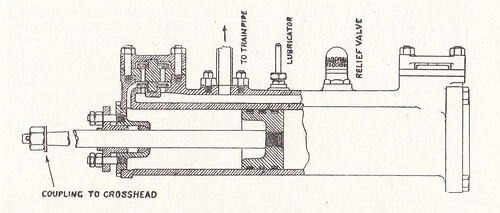skip to main |
skip to sidebar
2020 has been an apocalyptic year for the whole world. Life has been dominated by the spread of the Coronavirus pandemic so I hope this report doesn't appear too self-indulgent. This is the 15th annual review since I started this blog
OVERSEAS TRAVEL
In 2018, despite the limitations brought-on by ageing, I'd booked an expedition cruise with Noble Caledonia called 'Across the Tropic of Capricorn’ from Auckland (New Zealand) to Rabaul (Papua New Guinea). The itinerary included a number of days in the Solomon Islands which appealed to me and nobody had heard of Covid-19 at that time. By the time I set off on Saturday 8th February 2020, I had some misgivings but information about the new infection which had appeared in Wuhan, China was sparse. I'd finished the trip and been safely home again for a couple of weeks before the World Health Organisation finally declared a pandemic. It was a good trip, marred by being denied landing firstly in French-controlled New Caledonia, secondly in the Solomon Islands, which allowed us to spend extra time in friendly Vanuatu, and finally (and, we were assured, illegally) we were prohibited from landing in Rabaul, Papua New Guinea. This last refusal neccessitated unscheduled cruising to Port Moresby, also in Papua New Guinea where we left the ship in time to fly to Cairns, Australia, for a one-night hotel stay concluding the trip.
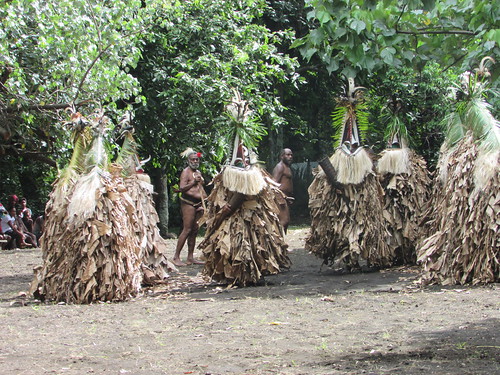
Elaborately-masked ‘devils’ in the Rom Dance: Ambrym, Vanuatu.
That was my only overseas trip in 2020. I'd already booked airline tickets to revisit my many friends in Myanmar (formerly called Burma) in April but, by that time, international travel had become impractical. At least the airline refunded the air fare, although it took a while.
To find more about overseas visits I've made in previous years, see:-
Jan Ford's Travels (2001 onwards).
Jan Ford's Travels - The early trips (before 2001).
Jan Ford's Travels: Around the World in pictures
(alphabetic list of countries with links to pictures).
TRAVEL IN THE UK
In a normal year, I would expect to make a number of trips (mainly by rail) to various destinations in the UK but this didn't happen in 2020. There was very little local travel either, apart from a small number of business trips for survey work. The most exotic UK journey was a rail trip to North Wales in connection with my work, which did produce an album of indifferent pictures titled Wolverhampton-Hawarden Bridge.

Borderlands Line Up Side (Hawarden Bridge): View from the swing bridge (now fixed) over the River Dee looking downstream
RAILWAYS AND PRESERVATION
All preserved railways were seriously affected by the Coronavirus pandemic. I continued as a member of the Old Locomotive Committee and remained a volunteer at The Battlefield Line but, with reluctance, resigned as a working volunteer at Peak Rail after many years on the footplate there.
The Old Locomotive Committee
The Old Locomotive Committee (OLCO) usually organises two events each year: the Annual General Meeting, normally held at the Museum of Liverpool where the locomotive 'Lion' is on public display and the 'Lionsmeet' event. 'Lionsmeet' enables live-steam models of 'Lion' to be run and members to meet up. This event is hosted at the running track of a different Society of Model Engineers track each time. In 2020, Coronavirus legislation led to both events being cancelled so OLCO's periodic newsletter called 'Lionsheart' has been particularly important in 2020.
All my posts about the Old Locomotive Committee are here and you can find more information (including how to become a member) on OLCO's website here.
The Battlefield Line
Services at the Battlefield Line in the previous year, 2019, had been quite intensive, including the 'Last Train Monmouth-Chepstow Re-enactment' at the beginning of the year, steam-hauled and DMU services throughout the season, the '50th Anniversary Gala' featuring three steam locomotives, Santa Specials using 'Wightwick Hall' and a 'Light Prairie', finally finishing the year with Mince pie Specials with the 'Hall'. On 28th December2019, I was on the 'Hall' (I didn't write-up the day until 2020, so I've included the link to this post in the list below.
The year 2020 started well enough, operating a winter gala in January with 'Wightwick Hall' and a shuttle service using the DMU and 'Light Prairie'. For some reason, the name of this gala was changed from 'Winter Warmer Gala' to 'Cold Turkey Gala', which was to prove prophetic. Following this gala, there was a planned closure of the line until Easter. However, because of the Coronavirus pandemic restrictions, the line was not able to re-open, with reduced services, until August. Volunteers and supporters were thus deprived of their 'steam fix' at the Battlefield Line for over six months, rendering the title of the earlier winter gala strangely appropriate ("Cold turkey" refers to the abrupt cessation of a dependence and the resulting unpleasant experience). Government pandemic restrictions changed frequently during 2020 but the Battlefield Line persevered with a modified and reduced service of 'Santa Specials' although I wasn't involved this year. On 30th December, a DMU 'Mince Pie Special' was run but, that afternoon, the government announced tightened pandemic restrictions effective at midnight that day, resulting in the remaining 'Mince Pie Specials' being cancelled, so I lost my booked DMU turn on 31st December.
My, rather limited, activities in the year (with links to my pictures) are listed below:-
A Day on the DMU 11-Oct-2020
Operations at the Battlefield Line in 2020
'Cold Turkey Gala' at the Battlefield Line 4-Jan-2020/5-Jan-2020
Mince Pie Specials at the Battlefield Line 2019 28-Dec-2019

6989 'Whitwick Hall' ready to leave Shackerstone with a 'Mince Pie Special', 28-Dec-2019.

Jan, pleased to be back on the footplate at the Battlefield Line, 16-Aug-2020 (Photo: D. Mould)
You can find all my posts about the Battlefield Line here.
Incidentally, you can find all my posts about Diesel Multiple Units here (or refer to the 'Index' here).
Peak Rail
In July 2020, in view of the limitations brought on by ageing and the travelling involved to and from Peak Rail, I reluctantly decided to step back from an active operating role at Peak Rail whilst remaining supportive of Peak Rail's objectives. Operations at Peak Rail were severely impacted by the pandemic and 'Santa Special' operations in 2020, whilst initially marketed, were eventually abandoned.
You can find all my earlier posts about Peak Rail here with links to my pictures.
Myanma Railways
Because of the pandemic, I was unable to visit Myanmar in 2020 so I've added little about Myanma Railways, although there are three new posts describing events during the 2019 visit:-
A trip to Bago - Technical Notes 6-Dec-20
Power Signal Box, Togyaunggalay 24-Jun-2020
Railway Operation Control Center, Yangon 05-Feb-2020
You can find all my posts about Myanma Railways (in reverse date-of-posting order) here or refer to the 'Index' here.
BREWOOD HALL
The committee which organises the Brewood Garden Party, held in the gardens at Brewood Hall, met at the beginning of the year to plan the 2020 event but after the Coronavirus pandemic was declared and an array of legal restrictions were imposed, it was clear that the event in 2020 would have to be abondoned - a decision reached with great sadness.
There's an album of pictures showing the 1-acre garden through the seasons in 2020 here. There's a separate album (covering a number of years) showing the fungi which appear annually, which is here.
During the year, as always, various repairs were carried out around the property but none, as yet, has spawned a blog post.
You can find all my posts about Brewood Hall (in reverse date-of-posting order) here.
TY GWYN
Ty Gwyn is a small commercial woodland around 27 hectares in area near Corwen in Wales. I made a visit on 29th September 2020 with Dean to meet Will Tomkins from Fountains Forestry who manage the woodland. We inspected the condition of the plantation and agreed the future maintenance programme. Both before and after the visit, Dean and I made the traditional stop at the excellent 'Country Cooks' restaurant at Ty Nant. The owners had experienced a difficult 2020 because of changing Coronavirus regulations and lockdowns. Just a few days after our visit, they had to close again.
There's a report on the visit to the woodland here

Jan at the Pool: Ty Gwyn 2020 (Photo: D. Mould)
To see all my posts on Ty Gwyn, click here.
'ROAD TO MANDALAY' SOCIAL CONTRIBUTION
For a number of years, I've supported the charitable initiatives operated under the above name in Burma. I'm also currently a trustee of the Belmond Myanmar Foundation in the U.K. which also provides support to this work. Educational Support is provided to a wide range of schools and orphanages (including the Orphans & Vulnerable Children Project in Mon State) and Medical Treatment to all ages (centred on the wonderful Bagan Medical Clinic). When I visit Burma, I try to see as much as possible of the projects in hand but, in 2020 this has not been possible.
Like the rest of the world, Burma has been badly effected by the pandemic. Local restrictions on travelling and social distancing resulted in severe limitation on educational support in 2020 and the Bagan Medical Clinic has had to close until the situation improves.
You can find all my earlier posts on Educational Support here.
You can find all my earlier posts on Medical Support here.
OTHER BLOG POSTS IN THE YEAR
This review covers trips and events during the year but doesn't always include other types of post such as:-
Technical articles;
Historical articles;
Work-related topics;
Recollections of past events;
PREVIOUS ANNUAL REVIEWS
2019
2018
2017
2016
2015
2014
2013
2012
2011
2010
2009
2008
2007
2006
Christmas in Brewood during the Coronavirus Pandemic has been like no other. Following a period of pre-Christmas 'lockdown', the area was placed in the government's Tier 3 regulations ('Very High Alert'). At least we avoided Tier 4 ('Stay at Home'). Most areas of life are covered by these regulations to try to control the spread of infection including hygiene, self-isolation (if typical symptoms of the virus appear), meeting people, travel, work, shopping, education, sport and religious services. In peacetime, there have never previously been such restrictions on the population.
The first vaccine for Covid-19 approved in the UK, made by Pfizer, gained emergency certification in December 2020 and the government programme for mass inoculation, starting with the most vulnerable groups, started just before Christmas. A second vaccine, from AstraZeneca, is expected to receive emergency certification imminently.
Although Christmas Lights were erected in Brewood Village as usual, the normal public festivities around the switching on of these lights had to be cancelled.
The start of December 2020 was cold but, when the sun shone, quite pleasant, as you can see from this drone picture my friend took on the 2nd December.
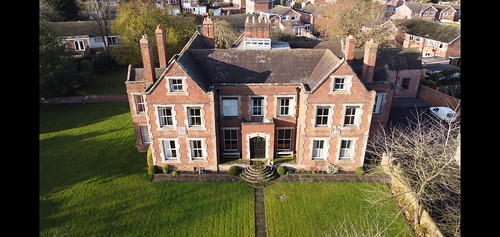
Brewood Hall: Picture from a quadcopter drone
Then the weather became very wet, causing flooding in many parts of the country. I noted the rise in level of the Brewood Stream, which runs just outside my home, on the opposite side of Sparrows End Line. Brewood Stream discharges into the River Penk just over half a mile away at Stone Bridge.

Brewood Stream at high level
Part of the flow coming down the Brewood Stream finds its way underground into a parallel system of sinks and issues in the field opposite Brewood Hall. In dry weather, this parallel watercourse is largely hidden but after heavy rainfall, a pond appears temporarily.

Temporary Pond viewed from the Holloway

Brewood Stream at high level, passing under Brewood Hall Bridge
There are a few more pictures of Brewood Stream during this period in the album Brewood: Around & About.
Although the ground has been very sodden, I've not heard of serious flooding locally affecting homes. Brewood Hall is situated at the foot of the hill on which the village centre is built so the elevation of the Hall is around 45 feet less than the village centre. During heavy rainfall, the cellars at the Hall become very wet with water finding its way from the hill to a lower level but the traditional building methods incorporating sumps to drain away this water naturally are effective and I've never actually seen the cellars flooded (so far!).
During December, I've usually participated in the operation of 'Santa Special' trains. Operation of preserved railways in the UK has been very difficult in 2020 because of Coronavirus and some railways (like Peak Rail) abandoned their Christmas programme of trains altogether. The Battlefield Line persevered with a modified and reduced service which was fully booked throughout but I wasn't involved this year. There's a post on the effect of Coronavirus on the Battlefield Line prior to the 'Santa Special' operations here.
There were different, complicated rules just applying to Christmas day making small groupings of people from up to three households legal. The Parish Church did have Christmas Services, but not in the normal format because of Social Distancing measures. Whilst some churches decided to issue tickets to the popular services, Brewood Parish Church decided to avoid the need for tickets by holding two 'Midnight Mass' services on Christmas Eve, spaced apart earlier in the evening, plus an 'on-line' version for those unable to attend in person.
Some parts of the UK had snow in time for Christmas Day but not Brewood where it was frosty morning and the local temperature was minus one Celsius. There was a weak sun, so I braved the cold as far as the garden to record the conditions.

Christmas Day at Brewood, 2020
My own Christmas was very low-key but we were able to observe the tradition of a Christmas Meal at Brewood Hall with Ann and Dean.

Ann celebrates Christmas

Dean celebrates Christmas
However, a few days later I awoke to find that it had snowed overnight so I was encouraged to don wellington boots and take a few pictures.

Snow at Brewood Hall, 28th Dec 2020
I then took a short walk up the ancient tree-lined footpath opposite the Hall. This formerly was a more significant thoroughfare which I've always believed was a 'sunken lane' or 'holloway'. There's a Wikipedia article here and an Atlas Obscura article here about holloways. The snow really emphasised the appearance of a holloway. I'm told that, years ago, locals called it 'The Dingle'.

Snow in the Holloway, Brewood (view looking south-east), 28th Dec 2020

Snow in the Holloway (looking north-west), Brewood, 28th Dec 2020
The final picture shows the 'temporary pond' (mentioned above) in the snow.

Snow and temporary pond, Brewood, 28th Dec 2020
Doctor Hla Tun had arranged an official visit to view the signalling arrangements at Bago on 9th May 2018 and this post adds some technical comments to the post A trip to Bago which describes that visit.
Bago is an important station on the double-track route from Yangon via Naypyitaw to Mandalay. It is also the junction for the single line to the south of Myanmar. Originally, this single line line terminated at Mottama but, with the opening of the Thanlwin Bridge, there is now a continuous railway to Mawlamyine and beyond.
At Bago there are two fully-interlocked mechanical signal cabins, one at each end of the station (South Cabin at Yangon end, North Cabin at Mandalay end) and a number of parallel loops through the station. I had previously seen a similar arrangement in use at Kyee Myin Daing (see the report of my visit to Kyee Myin Daing on 10th May 2017 here.
The Doctor and I arrived at Bago station at 1.00 p.m. and were ushered into the spacious meeting room. After introductions to Yin Min Oo, the Assistant Divisional Manager, the Signal Officer and two others who would accompany us on our tour, one of whom was an English speaker, we set off on our tour.
On the platform, we passed a particularly battered specimen of an Arrivals and Departures board. This board helps passengers find their correct coach, by showing the make-up of major passenger trains. Each coach is represented by a disc with vehicle details inscribed. The appropriate discs are hung on a horizontal series of small hooks so that the composition of each train is readily visible. Three trains are shown - I assume the apparent gaps in the train formation indicated are because of broken or missing hooks.
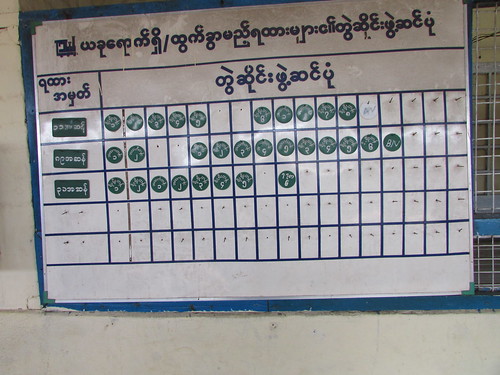
A particularly battered Arrivals and Departures board at Bago
Station Master's Office
The office which directs and authorises traffic movements in the Bago area they referred to as the 'Station Master's Office'. I think Myanma Railways may also use the term 'Sub-Control' for the more important locations.

Bago track diagram in Stationmaster's Office
Click for larger image
The Sub-controller (as I will provisionally call him) updates the train register book and writes out and issues the paper 'Line Clear' forms authorising train movements. The Sub-controller also has a radio, which links him with the Control Office in Yangon, and an impressive array of desk telephones. There's a hand-cranked magneto telephone which I think communicates with the Bago Signal Cabins and five auto telephones whose function I didn't discover.

The 'Sub-controller' in the Station Master's Office at Bago
At the 'Sub-controller' desks at Bago, there are two elderly items of electrical signalling equipment similar to those I'd seen on an official visit to Kyee Myin Daing in 2017 (described here). I assumed that, as at Kyee Myin Daing, they are used to instruct the two local signal boxes regarding the route through the station area to be taken by trains. There's also a third, similar instrument which I think is not in use.

Route Indicating Signalling Equipment, Bago (The Railway at Bago, 9th May 2018)
Each instrument is housed in a substantial, cast housing rather similar to some designs of electric token instrument, with the cast cover secured with a padlock. All indications and controls are on the front face. There are two 2-position galvanometers towards the top; one a lower-quadrant semaphore stop signal indicator, the other displaying text in a slot (ON/OFF, as far as I can determine). Below this is a window showing part of a rotating disc revealing different numbers, according to the angular position of the disc which is controlled by turning a commutator knob below the window. I've found displays of 'N', '1' and '3' so I assume this is how the desired road is selected. Near the bottom of the front is a substantial pull-out slide (rather similar to that on certain electric tablet machines). To the left of the slide, is a push-button (possibly to reset for the next route).
These instruments are connected electrically to the appropriate signal cabin, where the required route is visually indicated.

These 'GIVE CONTROL FOR' filamentary indicators in the signal cabin show the required route (The Railway at Bago, 9th May 2018).
Time didn't allow me to get to the bottom of this tantalising puzzle, so I'm afraid I still have only a hazy understanding of the set-up as our hosts were anxious to move on to the signal cabin at the Mandalay end of the station, Bago North.
I was keen to see the mechanical signalling at Bago at close quarters as it's to be abolished and all the delightful semaphore signals removed as part of the railway modernisation. My interest had been whetted travelling through Bago by train on 8th September 2012 during an uncomfortable journey from Yangon to Kyaikto, described in two posts here and here. Three days later, I returned to Yangon by road, stopping at Bago to add more photographs of the railway.
As we walked across the multiple tracks from the main platform to reach Bago North Signal Cabin, I kept stopping to take pictures of items of signalling equipment, including an example of one of the rather elegant ground disc signals.

One of the rather simple yet elegant ground disc signals at Bago (The Railway at Bago, 9th May 2018)
Bago North Signal Cabin
We entered the mechanical signal cabin of Bago North where, on the operating floor, two signalmen were on duty.

Bago North Cabin, overall view (The Railway at Bago, 9th May 2018)

Track Diagram, Bago North Cabin (The Railway at Bago, 9th May 2018)
Click for larger version
I photographed everything in sight for later study and the young signalman set up a route to demonstrate the operation of the levers (but I didn't ask to try myself). I asked to see the locking room and, again, took a number of photographs.
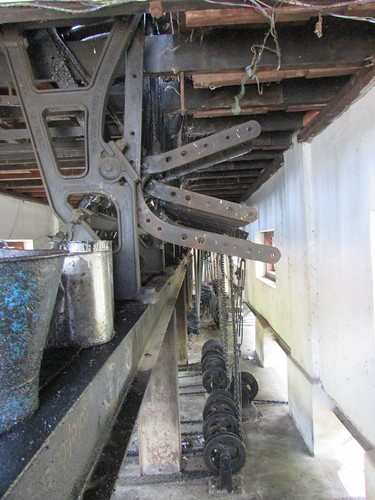
Bago North Signal Cabin: General view of locking room (The Railway at Bago, 9th May 2018)

Bago North Signal Cabin: Locking room, showing drive from levers to inclined locking tray (The Railway at Bago, 9th May 2018)

Bago North Signal Cabin: Locking room, showing detail of inclined locking tray (The Railway at Bago, 9th May 2018)
For more information on the control of trains in Myanmar, see the post here Alternately, there's an index of all my Myanma Railways posts (which may not always be up-to-date) here.
Bago Locomotive Depot
On 6th May 2015, I'd made a visit to Insein Locomotive Works in Yangon (described here) and was excited to find them restoring a couple of steam locomotives with the intention of using them to operate tourist trains. That didn't happen but the German travel firm FarRail Tours stepped in to support the costs and use the locomotives for photographic charters. I took a few pictures of the restoration work in progress which you can find here.
I knew from following the interesting FarRail Trip Reports that the three serviceable steam locomotives were normally kept in the shed at Bago. During the 2018 Bago visit being described, our hosts offered a visit to the locomotive shed so, of course, I quickly agreed. Any loco depot is full of interest and I quickly took a few pictures showing the office block with the sign for the Loco Ispector's Office (in English and Myanmar languages), a couple of Japanese 'RBE' diesel railcars, a single-ended Very Lightweight Diesel Railcar carrying the running number LRBE66, locomotive DF1205 (a 1200 h.p. Bo-Bo-Bo diesel electric but with single cab and very worn paint finish). There was a 'graveyard' of dismantled steam locomotives including a number of main frames with cylinders attached, a bogie, coupled wheelsets in two sizes and I don't know what else was hidden in the undergrowth.
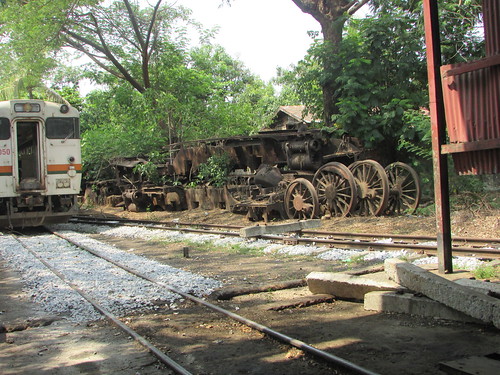
Japanese diesel railcar and 'graveyard' of dismantled steam locomotives (The Railway at Bago, 9th May 2018)
The original massive water tower survives. There are also three modern elevated, rectangular tanks. I think the left one is water - the others may be diesel fuel which I didn't confirm but they are ajjacent to three 3,500 gallon cylindrical fuel tanks, silver-painted and mounted horizontally. Nearby are two of the original inspection pits and a water column supplied by J. Blakeborough and Sons, Brighouse in 1904.

DF1205, original water tower, storage tanks, inspection pits and water column (The Railway at Bago, 9th May 2018)
I'd previously tracked down various non-operational examples of steam in Burma at various locations (there's a post here) but this was my first sighting of engines still steamable so I clambered onto the footplate of each of the three locomotives in turn, grabbing as many pictures as I could before our hosts became too restless.
The three locomotives are from two classes produced after World War II to allow Burma Railways to recover from severe war damage (at different stages during the war, Burma was bombed by both the the U.K. and Japan). Vulcan Foundry at Newton-le-Willows was involved in the building of these classes. There's a splendid website chronicling the history of Vulcan Foundry here.
One 'YB' class 4-6-2 for passenger service is preserved and two 'YD' class 2-8-2 mixed traffic locomotives. All three are oil-fired although, when withdrawn, some examples of these classes remained coal-fired.
The solitary 'Pacific' type, 'YB629' was standing outside the north end of the shed, coupled head-to-head onto 2-8-2 'YD964' which was the engine I'd identified under heavy repair at Insein back in 2015. At Bago, 'YD964' was standing over the Wheel Drop with the motion partly taken-down, presumably in need of running repairs. The second 2-8-2 was standing outside the south end of the shed. My pictures of these three survivors are in the album here, and I apologise for the poor quality of some of them in my haste to record as much as possible.

'YB629' 4-6-2 outside Bago Shed (The Railway at Bago, 9th May 2018)
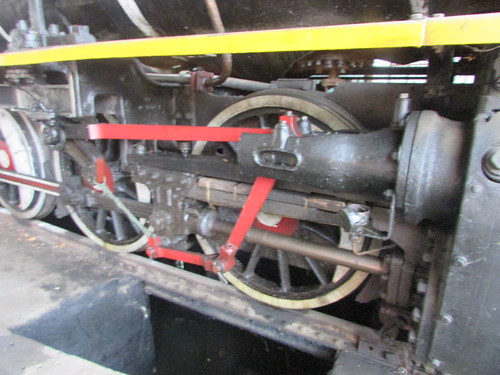
YD 964': View of driver's side showing partly-dismantled motion. Wood between the slidebars prevents the crosshead from moving. The locomotive is standing over the Wheel Drop (The Railway at Bago, 9th May 2018)

'YD967' 2-8-2 at Bago: For once, Jan looks quite happy (The Railway at Bago, 9th May 2018)
Bago to Yangon by Train
When our hosts managed to prise me away from the steam locomotives, I was all set for a visit to Bago South cabin but they said there was not enough time, so we made our way back to the station, this time using a public footbridge. However, they did suggest that I might like to return to Yangon by train, a suggestion I readily accepted. Train 32 from Naypyitaw (from where it departed at 08:00) was due to arrive, they said, at 15:00. They also suggested that my photographic opportunities might be better in an Ordinary Class coach, where all the windows were sure to be fully open, rather than an Upper Class coach. I agreed with their reasoning and a ticket was issued. Then they said the train was 15 minutes late and it actually arrived about 15:20. According to the rail travel website 'The Man in Seat 61' here, the train was not due in until 15:20 and was due to depart at 15:23, arriving Yangon at 17:00. Well, we left about 15:23 and cracked along at what, for a Burmese train, was a a very good speed. We made just one stop and arrived at Yangon Central Station at 17:00. The journey is described in some detail in the post Bago - Yangon by train.
Related posts on this website
This is one of a series of posts describing Myanma Railways.
Selecting label 'Myanma-Railways' or clicking here displays all the posts with this label in reverse date-of-posting order.
Alternately, there is an Index here (but it may not be always quite up-to-date).
My pictures
Where necessary, clicking on an image above will display an 'uncropped' view or, alternately, pictures may be selected, viewed or downloaded, in various sizes, from the albums below:-
Bago Station (earlier pictures).
The Railway at Bago, 9th May 2018.
Bago to Yangon by Train, 9th May 2018.
All my Myanma Railways pictures.
Introduction
In 2002, I made my first visit to China. I'd not heard of 'blogging' then (there's an interesting history of blogging in Ryan Robinson's blog here) so it was not until 2007 that I started to describe this trip in the post China. At that time, I was still using a 35mm roll-film Canon 'EOS' camera so I was quite sparing in taking photographs and those I did take didn't get scanned and made available on the internet for years.
The 2007 post covers Beijing area (Tiananmen Square, the Forbidden Palace, solo tour of the city and its subway, next day Ming Tombs, Chinese Hospital, Cloisonne factory, the Great Wall), flying to Xian (City Wall, Buddhist Monastery, Big Wild Goose Pagoda, next day Terracotta Army, Flying to Chongqing (board Yangtse cruise ship 'Pinghu', next day start our journey dowmnstream). Then, the description stops with the cheerful comment "I hope to tell you more later".
I didn't return to the topic until I talked about an incident in Beijing right at the end of the trip in the post here. That finally induced me to finish describing my introduction to China but with few pictures to prompt the memory and any contemporaneous notes lost long ago, it will be a little sketchy.
The Yangtse River
The Yangtse cruise proved a good choice as it enabled me to see some of the contrasts China offers, start to understand the importance of the river as an ancient highway and appreciate the breathtaking scope of some of the projects being undertaken in China as it asserts its place in the modern world.

Chongqing-Yichang Yangtse River Cruise (Map: China Discovery)
As described here I'd boarded 'Pinghu' in the dark one evening and the following morning we set off downstream with the weather misty and occasionally rainy. I think Fengdu Ghost City on the northern bank was our first stop, where I gathered contrasting impressions of an ancient temple on high ground and a modern town being demolished virtually by hand prior to inundation. As we continued downstream, there were demonstrations of Chinese arts and crafts on board.
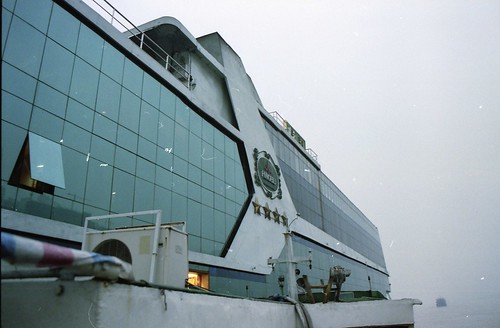
My cruise ship 'Pinghu', viewed from tender taking us ashore.

My cruise ship 'Pinghu', moored midstream in the Yangtse viewed from tender taking us ashore. Note the modern hilltop town top right of the picture.

My cabin aboard 'Pinghu' (Yangtse River Cruise)
Our next visit was to Baidicheng (which means white emperor city), an ancient hilltop fortress and temple complex offering views downstream towards the first of the Three Gorges we would pass through on our cruise - the Qutang Gorge. We had to climb a long, steep path to reach the site and I was rather tempted by the offers of transport to the top by groups of porters using home-made 'sedan chairs' comprising a sort of deck-chair with a simple roof fixed to a stout carrying beam. Resisting temptation, I made it both ways under my own power.

The steep path from the landing place to Baidicheng (Yangtse River Cruise)
I enjoyed wandering around the temple site which commanded good views of the Yangtse River and the Qutang Gorge we would cruise next. I've included a picture of Jan with a carved female guardian lion (Jan is on the left)

Jan and carved female guardian lion at Baidicheng (Yangtse River Cruise)

View of chair lift, suspension bridge and Qutang Gorge at Baidicheng in 2002 (Yangtse River Cruise)
The weather didn't improve as we made our way downstream. It was certainly 'atmospheric' but a bit damp. We passed through the Wu Gorge and went ashore for an excursion on a much smaller boat on a 60 km long tributary of the Yangtse called the Shennong Stream. It's an area of great beauty which I'm afraid we didn't see at its best. The rain sluiced down remorselessly so I didn't risk taking a camera but you can read a modern description of the area here, which talks about 'sampan drifting' in an unpowered, wooden-hulled double-ended craft (sometimes called a 'pod boat' because of its shape). We boarded one of these boats, with two helmsmen, one each end, each provided with a large oar principally used for steering. Of course, initially we were heading against the current so motive power was provided by a line of men scrambling along the bank ahead of us, man-hauling on a substantial rope attached to our vessel. The weather conditions made it difficult for the men to keep their balance and I witnessed a number of near-accidents. To add to the incongruity of the scene, all the haulers had donned plastic ponchos to keep out the worst of the weather. When the helmsmen decided we'd gone far enough, one of the shore party scrambled aboard the boat, bringing the haulage rope with him, leaving the rest of the men to make their way back to the loading point and, presumably, do it all again. Even in the rain and with impaired visibility, it was very pleasant to be silently drifting with the current back to our boarding point and it seemed a different world from the commercial bustle of the Yangtse with its procession of cargo ships and passenger ferries in both directions, occasionally punctuated by the loud exhaust of the hydrofoil ferries. Once safely back aboard 'Pinghu' and with the opportunity to dry-out, our journey continued into the third gorge - Xiling Gorge.
Despite the generally indifferent weather, I spent a fair bit of time outside on the upper deck, trying to absorb the majesty of the deep gorges and trying (but failing) to imagine the changes completion of the Three Gorges would bring, with the river level raised three hundred feet.

Signs on riverbank indicating planned rise in water level. The upper sign indicates 175m above sea level - the planned river level after completion of the Three Gorges Dam (Yangtse River Cruise)

Passing through the Three Gorges of the Yangtse River before inundation (Yangtse River Cruise)
The picture above also shows the mast on 'Pinghu' and the 'christmas tree' effect created by the various branches carrying navigation lights. After dark, I spent some time on the outside upper deck, fascinated by the amount of river traffic still moving, with the different displays of navigation lights indicating each ship's status - anchored, under way, towing.
I was disappointed by the actual Three Gorges Dam site. Although there was plenty of earthmoving going on, I'd failed to fully appreciate that we were passing what would become the base of the dam and that the impressive appearance of a large dam would only appear later. Our cruise terminated at Yichang where a large number of ferries were moored.

Ferry moorings at Yichang (Yangtse River Cruise)
I met up with a local guide who took me by car to the Chinese Sturgeon Museum set up in 1982 which is attempting preservation of this endangered species. There were interesting displays but I found the large, tiled pools housing live Chinese Sturgeon rather depressing, I'm afraid. There's a Wikipedia article here.

Chinese Sturgeon Museum, Yichang (Yangtse River Cruise)
Next, we visited Yichang Museum where there was a very well-displayed exhibition of artefacts from the area, many uncovered during the massive civil works involved in relocating towns along the Three Gorges at a higher level. Finally, I was taken to the Gezhouba Dam with its Navigation Locks allowing ships up to 10,000 tons to by-pass the dam. This project, started in 1970, was completed in 1988 and the 47 metre high dam has a generating capacity of 2.71GW. The scale of the ship locks is impressive but I was particularly taken by the almost continuous stream of pedestrians slowly making their way across the river, in both directions, using the walkways built along the top of the lock gates.

Gezouba: Navigation Lock Gate (Yangtse River Cruise)
My guide then took me to Yichang airport for my internal flight back to Beijing. Back in Beijing, I was returned to the same hotel I'd used on my arrival in Beijing to prepare for my final flight home. It was on a walk in Beijing before my transfer to the international airport that I had the unfortunate brush with the local police described here. Despite that hiccup, it had been a wonderful trip and I'm pleased that I got to see the Three Gorges before the dam was completed.
Related material on other websites
China's Mighty River (1930s article from 'Shipping Wonders of the World).
Yangtse River (Facts and Details site)
Chinese Sturgeon (Wikipedia)
My pictures of the 2002 trip
Beijing, China
Xian, China
Yangtse River, China
When I was growing up, telephone services in the United Kingdom were Nationalised and run as part of the General Post Office (GPO). This was logical since the Post Office handled written messages, in the form of letters, in massive numbers. Telephones offered an alternative, faster, method of sending a message. Back then, few homes had the luxury of a telephone but calls could be made from the familiar, red telephone kiosk. Although this gave you the means to communicate with businesses, its use for personal calls was limited since few relatives or friends would possess a telephone. Urgent communication in matters of accident, sickness or death could be expedited as a written message sent as a 'Telegram'. This involved going to a local post office where you could write a brief message on a telegram form and hand it over the counter. On payment of what seemed a lot of money, this would be transmitted by the Post Office to the office nearest your recipient by teleprinter, printed out on a continuous strip which was cut into short lengths and glued (yes, glued) to another telegram form, placed in an envelope and delivered to your recipient's address by a Telegraph Boy (often on a bicycle). Although my experience of using telephone and telegram services was limited, I became fascinated with telephones and telegraph equipment, possibly triggered by a visit I made, when still at school, to a Telephone Exchange. Back then, exchanges were electro-mechanical, rather noisy affairs, using relays, uniselectors and 2-motion selectors. Reed, crossbar and electronic exchanges were still to appear.
But when I started (unofficially) visiting railway signalboxes as described here, I discovered even earlier telecommunications systems (owned and operated by British Rail) still in use. The block system in use for securing the safe passage of trains from signalman to signalman used an arrangement of single-needle telegraph instruments with codes transmitted by single-stroke electric bells (as outlined in the post here). Telephones used were rather primitive, Local Battery affairs in wooden cases.

Local Battery Omnibus Telephone in wooden cabinet with hinging front. Tiltable carbon microphone and cord-mounted receiver stowed on cradle switch, D.C. bell on backboard. Polarised D.C. ringing-out on two buttons.
The GPO were introducing Subscriber Trunk Dialling into the public network (where customers set up their own long-distance calls without the intervention of an Operator), using 'Step-by-Step' Strowger technology. The first Subscriber Trunk Dialling (STD) call in the United Kingdom was made by Her Majesty Queen Elizabeth II on 5th December 1958. There's a brief introduction at Subscriber Trunk Dialling (STD) and a Wikipedia article here.
In 1959, the GPO introduced a 'modern' telephone instrument, still featuring a rotary dial. This formed the basis for what became an extensive range of models - the 700-series. Later members of the 700-series even featured push-button dialling! There's an interesting article on the 700-series instruments on Wikipedia here.
In the post The World of Work I talked about working for Contactor Switchgear (Electronics) Limited. The Sales Director had a number of contacts within British Railways and we bid for a number of telephone-related jobs, without any conspicuous success.
In 1966, I decided to set up in business on my own, as outlined in the post Starting my own business. Getting established proved quite difficult and I was quite happy to accept a variety of work. But an introduction to Gerry Gardner led to sub-contract design and manufacture of specialist telecommunications equipment for emergency services. Following the success of this equipment, we were invited to bid for the supply of selective call telephone equipment by British Rail. Manufacture of the resulting contracts led to a period of expansion and development of similar equipment for use as Electrification Telephone systems for British Rail, as described in the post Electrification Telephone Systems for British Rail. Subsequent schemes were supplied to British Rail and other companies like Westinghouse Brake and Signal.

Our equipment was installed in various Power Signal Boxes, including Preston shown in 2013
G.E.C. in Coventry asked us to design and supply telecommunications equipment for a large railway electrification project in Taiwan. Working for the Big Boys mentions some of my experiences and the report here has some recollections from my first visit to Taiwan to assist with commissioning this scheme.
Although we continued to do work in industrial automation (see Visiting Steelworks and Oil & Gas Industry) most work was channeled into telecommunications for railways. British Rail operated a number of large 'Step-by-Step' exchanges to handle internal telephone traffic and they designed their own version of STD (which they called Extension Trunk Dialling) to link these exchanges into one system. We were kept busy maufacturing the racks and relay sets for this scheme.
Two more large projects for G.E.C. followed - one in Brazil, the second in Thailand. These are briefly described in the post Work (part 2). A proposed commissioning visit to Brazil was cancelled at short notice so I didn't get to Brazil until my 'Round the World Two' trip in 2006 (very briefly described here). But I did visit Thailand a number of times during commissioning of that project (the post here outlines the scope, the post here includes a description of a day fault-finding travelling on a railway trolley and the post Thai Railfan Club describes some of the friendships I made).
Standard Telephones and Cables approached us about a complex railway telephone system for use in the Bombay area. We offered to build suitable equipment, but they were keen to manufacture 'in house' so, in the end, we concluded a license agreement. This involved visits to their manufacturing site in South Wales but I was disappointed not to be involved in commissioning the equipment in Bombay - I didn't get to India until 1992 when we commissioned equipment we'd supplied to G.E.C. for a railway telephone system in the Delhi area (see the post My first trip to India).
When we were asked in 1993 to quote G.E.C. for Tunnel Telephone equipment for the Jubilee Line Extension of London Underground, I initially baulked at the idea. None of our existing designs seemed adaptable and, despite the system name, the main function is to provide a high-integrity emergency traction shutdown system. The design challenge appealed to me but I initially assumed the development cost would make our offer uneconomic, as explained in the post Work (part 2). G.E.C. persisted and the supply of Tunnel Telephone equipment became an important, if erratic, source of business but it's so specialised that I tend to think of it as distinct from 'Telecommunications and Jan'. But there is a post called London Underground and Jan.
Related posts on this website
Selecting label 'Work' (or Clicking here) will display all my posts on 'Work' in reverse date-of-posting order. Alternately, Clicking here will display an index list of Titles of posts labelled 'Work' (but this list may not be up-to-date).
[Link URL corrected 26-Nov-2020]
Introduction
In the development of the locomotive engine the initial challenge was to make the machine go. Stopping was less of a priority and early braking systems were rudimentary (or absent). But as designs improved and the weight and speed of trains increased, the need for effective brakes became a priority. The common arrangement was a shaped brake block which could be clamped against a wheel tread, dissipating the energy of motion as heat. Although wooden brake blocks were originally common, their tendency to burst into flame encouraged the use of cast iron which wears away with the friction, neccessitating periodic replacement. To provide more retardation, brake blocks on a number of wheels could be coupled together by a mechanical linkage and operated from a manual handle, often via a screw arrangement. To provide still more brake force, steam-operated brakes were introduced. In the early years, the driver could only operate brakes on the locomotive. The train was braked by the Guard applying a hand-operated brake in the Guard's vehicle at the rear of the train and, in some cases, by assistant Guards applying hand-operated brakes on intermediate vehicles. The shortcomings of this arrangement gave rise to pressure to introduce better braking systems operating on the whole length of the train. Systems using cable (such as the Heberlein cable brake in Germany, described in a Wikipedia article here) and the Clark and Webb chain brake use by the London and North Western Railway in the U.K. for a time were tried but eventually two approaches triumphed, using either air or vacuum.
Braking on the Great Western Railway
Great Western engines were originally fitted with a powerful steam-operated brake which became standardised as a vertically-mounted cylinder, where the piston was pulled upwards when steam was applied. This movement was coupled, by a mechanical linkage co-acting with a screw handbrake, to brake blocks.
In the 1870s, continuous brake systems started to be fitted to trains and the Sanders vacuum brake was trialled by the G.W.R. in 1876. Following these trials, the improved Sanders-Bolitho system started to be installed but, in 1880, William Dean decided that the G.W.R. should design its own vacuum brake system and Joseph Armstrong was tasked with this work. The Great Western, always prepared to be different, set their vacuum brake 'released' level at '25 inches of mercury' whereas every other British railway was content with '21 inches of mercury'. I think it was Churchward (before he succeeded William Dean as Chief Mechanical Engineer) working with Armstrong who made this decision. There's sound logic behind their thinking. 'Vacuum' brakes can be described as 'differential pressure' brakes. The bigger the differential between 'released' (a partial vacuum of 25 inches of mercury) and 'full application' (atmospheric pressure), the greater the brake force which can be produced by a brake cylinder of a given size. Looked at another way, more leakage can be tolerated in at system designed to run at '25 inches' before the braking effort available is seriously compromised. There's a little more on the topic in the post MIC - Brakes.
The result was a cab fitting comprising steam and vacuum brake application valve combined with a live-steam ejector, together with a crosshead-driven vacuum pump. The diagrams below, from book reference [1], I think show an early form of the cab fitting and the vacuum pump. Later versions of the cab fitting include the now-familiar small vacuum cylinder to proportionally apply the steam brake when the vacuum brake is applied. When the handle is vertical (as in the diagram) the steam brake is released and, when in motion, the brake pump maintains the vacuum. Moving the handle to the right supplies steam to the ejector to rapidly create vacuum. Moving the handle to the left admits air to the train pipe in a graduable manner to apply braking.
 GWR Vacuum Brake Ejector and Application Valve
GWR Vacuum Brake Ejector and Application Valve
